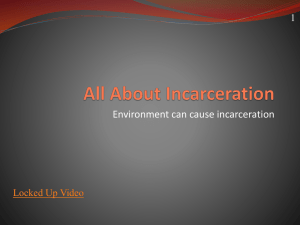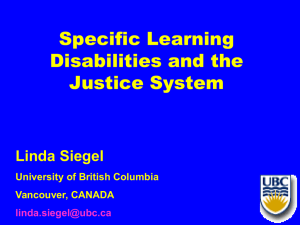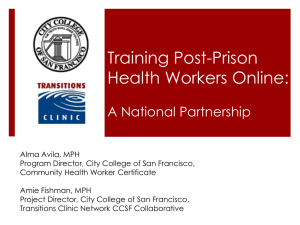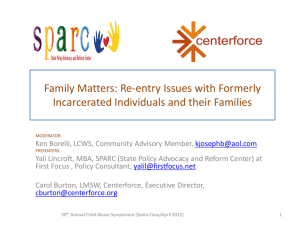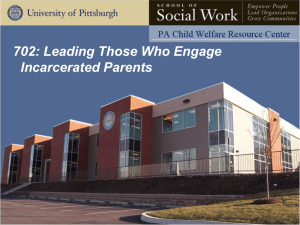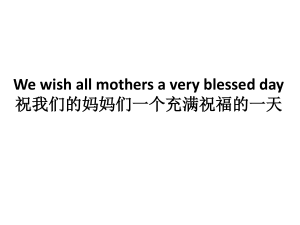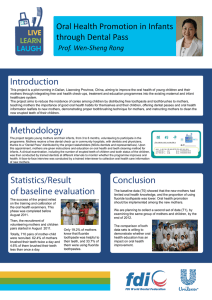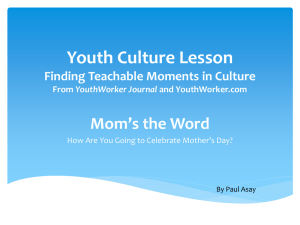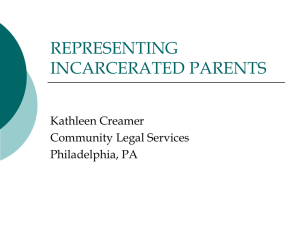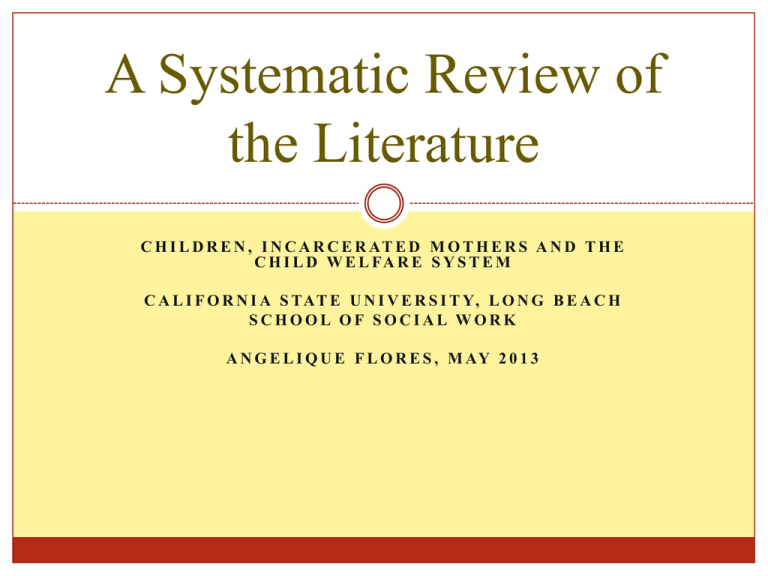
A Systematic Review of
the Literature
C H I L D R E N , I N C A R C E R AT E D M O T H E R S A N D T H E
C H I L D W E L FA R E S Y S T E M
C A L I F O R N I A S TAT E U N I V E R S I T Y, L O N G B E A C H
SCHOOL OF SOCIAL WORK
A N G E L I Q U E F L O R E S , M AY 2 0 1 3
Introduction
The total number of incarcerated mothers increased 122% since 1991 (Glaze &
Maruschak, 2010). Despite the increasing incidence, little is still known about the
particular risks facing children between the ages of 0 – 18 with incarcerated
mothers also involved with the child welfare system.
Most incarcerated women are single (62%), White (48%), and between the ages of
25 to 34. Parenthood is also a reality, with 55% of women having minor children
under the age of 18 (Glaze & Maruschak, 2010).
Research Questions:
1. What are the risk factors for children in the child welfare system with
incarcerated mothers?
2. What types of programs and social support services are available for children of
incarcerated mothers?
3. What is the effectiveness of the existing types of programs in the United States
working with child welfare agencies towards the reunification of mothers with
their children?
Social Work Relevance
Examining children of incarcerated mothers also
involved in the child welfare system is important
to social work practice, social policy
development, and as a basis for further research.
This study can contribute to the body of
knowledge for social workers and provide
assistance towards the development of programs
and social support services for children of
incarcerated mothers.
Cultural Relevance
Consideration of race and ethnicity are critical issues
when examining incarcerated mothers and their
children. Racial and ethnic minorities are
disproportionately represented in the criminal justice
system in comparison to their representation in the
general population (Glaze & Maruschak, 2010).
Continued awareness and development of appropriate
services are needed for people of diverse backgrounds.
Evidence-based interventions that employ race, ethnic,
and gender specific modalities need further
development (Miller, 2006).
Methods
Research Design: Qualitative, comparative
analysis method (Miles & Huberman, 1994;
Bradley, Curry, & Devers, 2007).
Data Collection Method: Reference library
professional as well as comprehensive search of
academic databases.
Sample: 20 – 25 articles during the past 15 years.
Analysis Plan: “PICO” method (Gambrill, 2006).
Results
Many incarcerated mothers are imprisoned as a result of
activities related to substance abuse problems (Mumola,
2000).
This review of the literature presented research indicating
a lack of programs and services focusing on drug
rehabilitation for women offenders with children
(Beckerman, 1998; Craig, 2009).
Imprisoned mothers face many obstacles to avoid having
their parental rights terminated (Beckerman, 1998;
Halperin & Harris, 2004; Hayward & DePanfilis, 2007).
Results Cont.
Child welfare agencies need to work collaboratively with
correctional institutions and implement nationwide
programs to meet the needs of incarcerated mothers and
their children more effectively.
Also unaddressed are the problems facing children from
the trauma of maternal incarceration. This literature
review found no current information or reliable data
indicating any significant improvements regarding special
programs targeted towards children with incarcerated
mothers.
Implications for Social Work Policy & Practice
Research indicates that children of incarcerated mothers
in the child welfare system are at risk for higher rates of
antisocial and delinquent behavior than children whose
mothers are neither incarcerated nor involved in the
child welfare system (Cho, 2010; Foster & Hagan,
2007; Dallaire, 2007; Murray & Farrington, 2008;
Murray, Seokol, & Olsen, 2009). Social work
practitioners should create additional social service
support for these children through partnerships among
child welfare systems, correctional systems and prisoner
advocacy groups.
Implications for Social Work Research
More research is needed to better understand the impact of
maternal incarceration on children. While children of
incarcerated mothers are at risk of experiencing many
adverse outcomes, the exact cause of these outcomes and
how to improve them is not clear (Hairston, 2007; Shlafer &
Poehlmann, 2010).
Another gap in the literature involves the reunification of a
formerly incarcerated mother with children who have been
in the child welfare system (Gleeson, 2007; Hairston, 2009;
Laughlin, Arrigo, Blevins, & Coston, 2008). Regarding
those instances particularly involving kinship foster care, the
research is minimal.
References
Beckerman, A. (1998). Charting a course: Meeting the challenge of permanency planning for children with incarcerated mothers. Child Welfare League of America, 77, 513-529.
Bradley, E., Curry, L., & Devers, K. (2007). Qualitative data analysis for health services research: Developing taxonomy, themes, and theory. Health Research and Educational
Trust, 60, 1758-1772.
Cho, R. M. (2010). Maternal incarceration and children’s adolescent outcomes: Timing versus dosage. Social Service Review, 84, 257-282.
Craig, S. C. (2009). A historical review of mother and child programs for incarcerated women. The Prison Journal, 89(1), 35-53.
Dallaire, D. H. (2007). Incarcerated mothers and fathers: A comparison of risks for children and families. Family Relations, 56, 440-453.
Foster, H., & Hagan, J. (2007). Incarceration and intergenerational social exclusion. Social Problems, 54, 399-433.
Gambrill, E. (2006). Social work practice: A critical thinker’s guide (2nd ed.). New York, NY: Oxford University Press.
Glaze, L., & Maruschak, L. M. (2010). Parents in prison and their minor children. Retrieved from http://www.ojp.usdoj.gov/bjs/pub/pdf/pptmc.pdf
Gleeson, J. (2007). Kinship care research and literature: Lessons learned and directions for future research. The Kinship Reporter, Child Welfare League of America, 1(2), 1-12.
Retrieved from http://www.cwla.org/programs/kinship/kinship summer2007.pdf
Hairston, C. F. (2007). Focus on children with incarcerated parents: An overview of the research literature. Retrieved from http://www.aecf.org/~/media/Pubs/Topics/
Child%20Welfare%20Permanence/Foster%20Care/KinshipCareWhenParentsAreIncarceratedWhatWeKn/10147801_Kinship_Paper06a%203.pdf
Hairston, C. F. (2009). Kinship care when parents are incarcerated: What we know, what we can do. Retrieved from http://www.aecf.org
Halperin, R., & Harris, J. L. (2004). Parental rights of incarcerated mothers with children in foster care: A policy vacuum. Feminist Studies, 30(2), 339-352.
Hayward, R. A., & DePanfilis, D. (2007). Foster children with an incarcerated parent: Predictors of reunification. Children and Youth Services Review, 29, 1320-1334.
Laughlin, J. S., Arrigo, B. A., Blevins, K. R., & Coston, C. T. (2008). Incarcerated mothers and child visitation: A law, social science, and policy perspective. Criminal Justice
Policy Review, 19, 215-238.
Miles, M. B., & Huberman, M. (1994). Qualitative data analysis: A sourcebook of new methods (2nd ed.). Beverly Hills, CA: Sage.
Miller, K. M. (2006). The impact of parental incarceration on children: An emerging need for effective interventions. Child and Adolescent Social Work Journal, 23(4), 472-486.
Mumola, C. J. (2000). Bureau of Justice Statistics special report: Incarcerated parents and their children. Washington, DC: U.S. Department of Justice.
Murray, J., & Farrington, D. P. (2008). The effects of parental imprisonment on children. Crime and Justice, 37(1), 133-206.
Murray, J., Farrington, D. P., Seokol, I., & Olsen, R. F. (2009). Effects of parental imprisonment on child antisocial behavior and mental health: A systematic review. Retrieved
from http://www.campbellcollaboration.org/lib/
Shlafer, R. J., & Poehlmann, J. (2010). Attachment and caregiving relationships in families affected by parental incarceration. Attachment and Human Development, 12(4), 395415.


